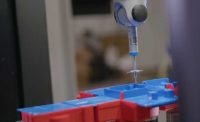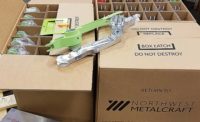The appeal of 3D printing is strong and growing among manufacturers in all sectors. For those in the aerospace industry, this technology offers a way to quickly and economically produce lighter parts that reduce airplane mass and fuel consumption.
Sogeclair Aerospace S.A.S. is an engineering design firm based in Blagnac, France, that has used 3D printing for several years. Established in 1986, Sogeclair offers consultancy and management services to OEMs worldwide in product configuration, data management, aero structures, systems installation, aircraft interiors, manufacturing engineering and equipment.
Recently, Sogeclair engineers looked into the feasibility of 3D printing an assembly-ready airplane access door. This type of door is located at the nose’s fuselage and used by operators for airplane inspection and maintenance.
Working with Sogeclair on the project were casting specialists from CTIF and Ventana Aerospace, and technical representatives at Voxeljet AG, a German manufacturer of 3D printers that use binder-jetting technology to join sand and plastic.
Early on in the project, the collaborators realized that 3D printing an assembly-ready door presented many challenges, beginning with the door’s large size and function integration. In addition, the door is made of AS7G06 aluminum, which the aeronautics industry has not yet approved for 3D printing using the direct metal laser melting process. Also, the door possesses a thin skin with tight dimensional and geometrical tolerances.
In light of these challenges, the engineers decided a better approach is to cast the door in metal from a 3D-printed resin pattern. They optimized the process by using Altair Engineering Inc.’s HyperWorks software suite.
Pattern creation required several steps. A CAD model of the door was created, and a finite element analysis (FEA) of its material properties performed. Next came a total of eight topology optimization processes and four mechanical stress checks to achieve a satisfying design. Topology optimization involves carving material away from design spaces to create the lightest structure capable of withstanding the applied forces.
The engineers then used the software to simulate a solid fraction casting of the door to minimize the presence of shrinkage and cracking. Finally, filling and solidification simulations were run to accurately predict the position and size of certain defects, such as incomplete filling areas or air bubbles.
According to Matthieu Deloubes, innovation leader at Sogeclair, the engineers then 3D printed the door at full scale in polymethyl methacrylate resin using binder-jetting technology. In this process, the resin is soaked in barbotine and coated with a shell composed of several layers of sand to build the mold. When the mold is heated, the resin is eliminated. The door is then cast, removed from the mold and heat treated.
Deloubes says that three tools in the HyperWorks suite enabled the company to successfully complete the project in only two months. They are OptiStruct (for FEA), HyperMesh and HyperView.
“[All three are now] used on an everyday basis and help us to come to the best possible solution for each design,” says Deloubes. “With HyperWorks, we have robust tools that offer an efficient way of working on all of our projects.”
He adds that company designers have begun working with Inspire, a design and rapid simulation tool in the HyperWorks suite, because it quickens the initial design phase of a part. For more information on simulation software, call 248-614-2400 or visit www.altair.com.





